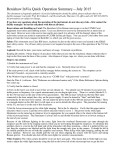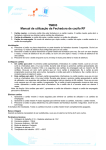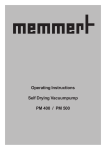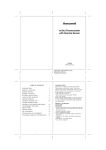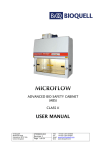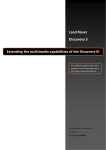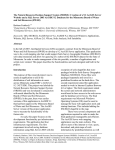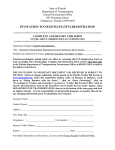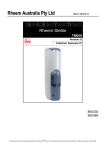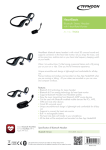Download TM001 - Introduction to Raman spectroscopy
Transcript
Wire%4%Training%Modules%Compilation% ! The!following!modules!are!in!this!compilation:! ! TM001! ! Introduction!to!Raman!Spectroscopy! TM002! ! Introduction!to!WiRe!and!System!start?up! TM003! ! Sample!viewing!and!configuration!change! TM004! ! Data!acquisition!and!measurement!set?up! TM007!! ! White!light!image!capture,!montaging!and!Surface! TM012!!! ! Data!processing!and!simple!analysis! TM026!!! ! FAQ’s! ! The!modules!above!as!individual!documents!and!other!more!specialized!modules!and! training!videos!are!available!to!users!with!a!Cornell!NetID!in!a!folder!at!! https://cornell.box.com/s/gxy4pkeo2od1bdukdx3d! ! The!modules!not!included!in!the!compilation!and!the!training!videos!are:! ! Videos!(in!mp4!format):! ! TM007(MO)!1! An!introduction!to!surface! TM007(MO)!2!! Defining!a!surface! TM007(MO)!3!! Applying!a!surface!to!white!light!images!and!montages! TM007(MO)!4!!! Applying!a!surface!to!map!data!collection! TM011(MO)!! ! 3D!viewer! TM012(MO)! ! Baseline!subtraction! TM013(MO)! ! Cosmic!ray!removal! TM013(MO)! ! Noise!filtering! TM017(MO)! ! Image!domain!analysis! TM018(MO)! ! Importing!and!saving!Raman!data! TMO18(MO)! ! Viewing!and!controlling!Raman!images! ! The!training!modules!not!included!in!the!compilation!but!available!individually!are:! ! TM005! ! Depth!profiling! TM006! ! FocusTrack! TM008! ! Point!Imaging! TM009! ! StreamLineHR!imaging! TM010! ! StreamLine!imaging! TM011! ! 3D!imaging! TM013! ! Multi?file!processing! TM014! ! Multi?file!data!analysis!(univariate)! TM015! ! Multi?file!data!analysis!(multivariate)! TM016! ! Database!searching!and!creation! TM017! ! Image!domain!analysis! TM018! ! Importing!viewing!and!saving!spectral!and!image!data! TM019! ! Labelling!and!printing! TM021! ! Polarizer?analyser!accessory! ! ! ! Renishaw plc Spectroscopy Products Division Old Town, Wotton-under-Edge, Gloucestershire GL12 7DW United Kingdom Tel Fax Email +44 (0) 1453 524524 +44 (0) 1453 523901 [email protected] www.renishaw.com TM001 - Introduction to Raman spectroscopy WiRE™ 4.0 What is Raman scattering? Raman scattering is named after the Indian scientist C.V. Raman who discovered the effect in 1928. If light of a single colour (wavelength) is shone on a material, most scatters off with no change in the colour of the light (Rayleigh scattered light). However a tiny fraction of the light (normally about 1 part in 10 million) is scattered with a slightly different colour (Raman scattered). This light changes colour because it exchanges energy with vibrations in the material. This makes Raman scattering an excellent tool for probing vibrations in materials. The aim of Raman spectroscopy is to analyse the Raman scattered light and infer from it as much as possible about the chemistry and structure of the material. More on Raman scattering Scattering occurs when an electromagnetic wave encounters a molecule, or passes through a lattice. When light encounters a molecule, the vast majority of photons (>99.999%) are elastically scattered; this Rayleigh scattering has the same wavelength as the incident light. However, a small proportion (<0.001%) will undergo inelastic (or Raman) scattering where the scattered light undergoes a shift in energy; this shift is characteristic of the species present in the sample. This process is shown in in Figure 1. Before Raman scattering After Raman scattering Molecule vibrating Molecule Laser excitation Raman scattering Fig. 1. Schematic diagram of the Raman effect Figure 2 illustrates the transitions accompanying Rayleigh and Raman scattering. The electric field of the incident light distorts the molecule’s electron cloud, causing it to undergo electronic transitions to a higher energy ‘virtual state’; not a true quantum mechanical state of the molecule. Raman scattering results in the release of a scattered photon with different energy to the incident photon; the difference in energy is equal to the vibrational transition, ΔE. The relative intensity of stoeks ans anti-Stokes lines at room temperature is shown in Figure 3. -1- TM001-02-A Introduction to Raman spectroscopy v’3 v’2 v’1 v’0 v’3 v’2 v’1 v’0 Virtual energy level Virtual energy levels hvi hvs = hvi - ΔE hvi hvs = hvi + ΔE ΔE v3 v2 v1 v0 hvi hvs = hvi Fig. 2. The electronic transitions accompanying Raman scattering (left), Rayleigh scattering (right) Fig. 3. Raman spectrum of silicon (514 nm excitation) showing the Rayleigh scattering at the laser wavelength and the Stokes and anti-Stokes line of the Raman scattering 2 v3 v2 v1 v0 TM001-02-A Introduction to Raman spectroscopy What does a Raman spectrum look like? Figure 4 shows the Raman spectra of two carbon based species, diamond and polystyrene. In Raman spectroscopy we are interested in how much the scattered light differs from the incident light, so the spectrum is normally plotted against the difference between the two - the Raman shift. Diamond has one main Raman band only because the tetrahedral lattice is symmetrical and all the carbon atoms and connecting bonds are equivalent. Polystyrene has different functional groups consisting of differing atoms and bond strengths. Each Raman band represents either a discrete function group (e.g. C-H from benzyl group at ~3200 cm1 ) or a combining of small groups into a larger group (e.g. C6H5R breathing mode from benzyl group at ~1000 cm-1). Diamond Fig. 4. Raman spectra of diamond and polystyrene The bottom axis of the graph represents the energy of the Raman shift (measured in cm-1) and may be plotted right-to-left or vice versa. A value of 0 cm-1 would indicate that no energy has been exchanged with the sample and the incident light is scattered with no change in wavenumber. Carbon-hydrogen bonds give rise to Raman bands around 3000 cm-1, due to the small mass of hydrogen and resulting high frequency vibrations. Peaks at lower wavenumber relate to lower energy vibrations such as those of bonds to carbon or oxygen. 3 TM001-02-A Introduction to Raman spectroscopy What information can you get from Raman spectroscopy? Raman bands can be analysed to obtain chemical and structural information for the material identification, investigation of material properties and spatial analysis. The table below illustrates the variety of results that can be obtained from point and mapping measurements. Band parameter Univariate Characteristic Raman frequencies Information Identification (material composition) Compare characteristic Raman frequencies Differentiation Intensity variation with changing polarisation Crystallographic orientation Variation in absolute / relative intensity Absolute / relative concentration Variation in Raman band width Crystallinity; Temperature Variation in Raman band position Stress state Multiple spectra Any of the above parameters applied to Any of the above information in conjunction multiple spectra: with different dimensions such as time, • Univariate – based on raw data or curve temperature, distance, area, and volume, e.g. fitting. • Thickness • Multivariate – algorithm based e.g. (Intensity with depth – 1D) DCLS, PCA, MCR-ALS or • Domain size and distribution TM EmptyModelling . (Intensity with area – 2D / 3D) Table 1. Information obtainable from analysis of different Raman band parameters. 4 TM001-02-A Introduction to Raman spectroscopy Raman spectroscopy obtains such information by probing the vibrational states of materials. Renishaw’s inVia can also be used for photoluminescence (PL) measurements, which is a competing effect to Raman. PL is typically much stronger in intensity and is a function of the electronic states of the material. The PL effect can sometimes provide an unwanted broad background that can mask the Raman bands. However, PL measurements can also provide useful complementary information on material properties such as conjugation, structural vacancy, and atomic substitutions. What does a micro-Raman instrument usually consist of? It usually consists of: • • • • • • A monochromatic light source (normally a laser) A means of shining the light on the sample and collecting the scattered light (often this is a microscope) A means of filtering out all the light except for the tiny fraction that has been Raman scattered (often holographic ‘notch’ or dielectric ‘edge’ filters) A device (such as a diffraction grating) for splitting the Raman scattered light into component wavelengths, i.e. a spectrum. A light-sensitive device for detecting this light (normally a CCD camera) A computer to control the instrument and the motors and analyse and store the data Figure 5 shows the layout of Renishaw’s inVia Reflex Raman microscope, with all the key components highlighted. Research grade Leica microscope Auto excitation wavelength switching Auto confocality control Ultra-high precision multiple grating stage Auto view/Raman changeover Auto calibration Auto performance verification UV capability Raman imaging capability Near-excitation filter capability Wavelength optimized laser beam control Class 1 laser safe enclosure Flexible sample handling Auto alignment optimization Safety interlock control Fig. 5. Renishaw’s inVia Reflex Raman microscope 5 TM001-02-A Introduction to Raman spectroscopy 6 Renishaw plc Spectroscopy Products Division Old Town, Wotton-under-Edge, Gloucestershire GL12 7DW United Kingdom Tel Fax Email +44 (0) 1453 524524 +44 (0) 1453 523901 [email protected] www.renishaw.com TM002 – Introduction to WiRE and System start-up WiRE™ 4.0 The aim of this module is to provide a general overview of the WiRE software, and detail the correct procedure for Raman microscope, laser, PC, and software start-up. Please note that this module is a guide and not a complete protocol. WiRE software WiRE software is designed to: • Control Renishaw Raman instruments • View the sample • Control data collection parameters • View data • Provide processing functions to improve data • Provide analysis options to determine information from Raman data • Enable data and results to be printed and exported for analysis / reporting Architecture of the WiRE software Menu and toolbar Menu and toolbar -1- TM002-02-A Introduction to WiRE and System start-up • • • • Toolbar buttons offer shortcuts to menu items Right click on the toolbar to control which groups are shown. Right click on a group to control the individual buttons which are shown The toolbar contents is configurable for different users who log on to the PC Sample review Sample review • • • • Controls the view of the sample on the video (white light, and/or laser) Aids focussing onto the sample Opens/closes the instrument shutter for laser entry into the instrument Controls the laser – grating – detector configuration used for new measurements 2 TM002-02-A Introduction to WiRE and System start-up Video Video • • • • Turn on/off and change the type of crosshair used View the axes View the scalebat Change the properties fo the video display including brightness, contrast and exposure time 3 TM002-02-A Introduction to WiRE and System start-up Spectrum viewer Window with spectrum viewer • • • View and control the spectrum, or spectra Control the view (add labels) 4 View processing and analysis operations TM002-02-A Introduction to WiRE and System start-up Map review • • • • View the individual or combined white light image and Raman images View spectra from different image locations Review how spectra have been analysed in conjunction with the Raman image Access the look up table to control image colour, contrast and brightness 5 TM002-02-A Introduction to WiRE and System start-up Navigator The Navigator • • • • • • Enables control of what data is open and where it is viewed Windows – Measurement - Viewers and data housed together (different viewers for different types of data) Measurement enables identical (or modified) conditions to be used for new data collection Access to experimental conditions Control of spectra from multi-files Saving of spectra, profiles and images 6 TM002-02-A Introduction to WiRE and System start-up Notification area Notification area • Progress bar indicating data acquisition progress • File signing when using 21 CFR pt 11 • Sample location within video (XYZ values) • XY spectrum co-ordinates or XYi Raman image values • Laser interlock status • Instrument active indicators • Access to experimental conditions • Controlsystem of spectra from multi-files Complete start-up • Saving of spectra, profiles and images This procedure assumes all electrical components relating to the use of the inVia Raman microscope are switched off initially, and that the user has suitable knowledge of Renishaw’s WiRE 4 software. 1. Turn on the system using the main on/off power button situated to the right hand side of the instrument. (the CCD camera will take ~ 20 minutes to cool to its operating temperature). 2. Turn on the desired laser(s), and ensure all keys and switches are correctly set (please refer to the laser user manual for individual laser start-up procedures) 7 TM002-02-A Introduction to WiRE and System start-up 3. The laser interlocks will not be activated until the WiRE 4 software has been opened. From point of lasing each laser requires at least 30 minutes to reach optimal pointing and power stability. 4. Turn on the PC, and run the WiRE 4 programme. 5. The software will prompt for a position check of the relevant motors. 6. Choose the ‘Reference un-referenced motors only’ option, and click on ‘OK’. Partial system start-up Typically some of the components will already be on when the system is to be used, and therefore the start-up procedure should be modified accordingly. The following is an example of how the system might usually be found, and the correct procedure, in this case, to complete the initial start-up. Example 1 The inVia Raman microscope is on, and the PC is on and the WiRE 4 programme is open. All lasers are off. 1. Clear all data and windows from WiRE 4 (checking that no unsaved data is further required). 2. Turn on the appropriate laser(s). 3. Wait for the required time period for the optimum laser stability to be reached. Example 2 8 TM002-02-A Introduction to WiRE and System start-up The inVia Raman microscope is on, and the PC is on and the WiRE 4 programme is closed. All lasers are on. 1. Open WiRE 4 (there will be no prompt for motor referencing as the current state of the motors will be recognised by the software, and referencing is not necessary). 2. The laser state will not change and all lasers will remain on. 3. The system can be used immediately. Example 3 The inVia Raman microscope is on, and the PC is on and the WiRE 4 programme is closed. All lasers are off. 1. Turn on the appropriate laser(s). 2. Run WiRE 4 (there will be no prompt for motor referencing as the current state of the motors will be recognised by the software, and referencing is not necessary). 3. Wait for the required time period for the optimum laser stability to be reached. Having powered up all the system components, and waited for stability to be reached, the system is now ready to be configured. 9 Renishaw plc Spectroscopy Products Division Old Town, Wotton-under-Edge, Gloucestershire GL12 7DW United Kingdom Tel Fax Email +44 (0) 1453 524524 +44 (0) 1453 523901 [email protected] www.renishaw.com TM003 – Sample viewing and configuration change WiRE™ 4.0 This module details recommended procedures for: 1. Viewing different types of samples using the Renishaw video. 2. Selecting different laser / grating / CCD camera configurations within the inVia Raman microscope. Suitable knowledge of the WiRE 4 software is assumed in this document. Sample viewing inVia and inVia Reflex Raman microscopes typically consist of direct microscope sample viewing using eye pieces and/or a microscope video camera. The Sample review is opened from the View menu or short cut button. The Sample review contains: • • • • • • Laser shutter control within inVia Objective selection (not motorised) Laser power control for viewing Laser defocusing control for viewing Selection control of Laser Selection control of grating Where configured within inVia, additional controls for laser polarisation for viewing, and CCD detector selection may be available. inVia shutter Objective Laser power Laser defocus Grating Laser Figure 1. inVia sample review In addition to these, the inVia Reflex Sample review contains: • • • • • • Viewing control of eye piece and video (white light only) Viewing control of video only (white light and laser) Viewing control of internal reference laser focus Illumination brightness (on/off and intensity) Aperture stop control Field stop control For inVia these options are all configured manually using the microscope. -1- TM003-02-A Sample viewing and configuration change Video only (laser and white light) Internal reference (video only) Aperture stop (A stop) Eye piece and video (white light only) Illumination (on/off) Illumination (intensity) Field stop (F stop) Figure 2. inVia Reflex sample review Whether used manually or through the Sample review, the illumination control, A stop, F stop, and camera control are used together to aid focussing and sample viewing and generate high quality white light images of the sample. Focussing the sample is aided by F stop, white light focus, and laser focus. Typically the sample is initially viewed using a low magnification (e.g. 5×) objective. If the sample has features these can be focussed using white light. Closing the F stop will reduce the field of view and produce an octagonal ring. When the edge of this ring is sharp, the sample is nominally in focus. This is of particular use for featureless samples. The laser spot / line and white light are co-focal for most visible and near infra-red laser wavelengths. Therefore when the laser spot is in focus the sample is in focus with the white light. The sample focus can be checked by moving sample position and seeing an equivalent change on the video. Progress through higher magnification objectives, refocusing each time, until the objective to be used for data collection is reached. Achieving the best video image requires appropriate control of the illumination control and video settings for different types of sample (different colours and reflectivities). The closed aperture stop produces high contrast images at the expense of reduced illumination. For most samples the A stop should be closed to achieve the best image quality. The properties of the video can be controlled by the user to optimise exposure, and gain. Depending on the sample reflectivity it may be appropriate to use auto settings to achieve the best quality (note that under these settings the frame rate may reduce the responsiveness of the video). 2 TM003-02-A Sample viewing and configuration change To change the video properties, right click on the video image and select Video properties. Figure 3. Video properties Under the main property page the user can apply image averaging to the video. This can reduce noise for dark/low contrast samples but may affect video responsiveness. The Capture filter properties contain the different camera settings. For the latest camera (Figure 4) set the gain to high (no auto) and adjust the exposure as necessary. 3 TM003-02-A Sample viewing and configuration change Figure 4. Video property settings Using auto exposure adapts the exposure based on the image contrast and brightness but may not be appropriate for all sample types, where the F stop is closed, or where auto mode continually hunts (does not produce a signle stable exposure value). In these scenarios turn off auto exposure from this dialogue. The size of the video window can be changed to balance the desired image resolution and image size. Select the Video capture pin button and choose a display resolution. Ensure the aspect ratio of the video is kept the same as this will otherwise affect the calibration of the video. Figure 5. Latest Renishaw video option Configuration selection The sample review shows the current instrument configuration (laser/grating) and also allows the configuration to be changed. 4 TM003-02-A Sample viewing and configuration change Figure 6. inVia Reflex sample review Current Laser and grating configuration Changing configuration To change configuration The user must know the desired laser, grating, and detector they intend ot use for their analysis. Some combinations are not appropriate, and when attempting to collect data a message will appear to inform the user that this configuration is not calibrated (and therefore should not be used). When the ‘Laser’ is changed, several or all of the following will occur immediately on selection dependent on the system type: • • • • • Motorised beamsteer autochange (only if the motorised beamsteer mirrors are installed) Motorised Rayleigh filter change (only if the motorised Rayleigh filter change is installed) Beam expander autochange (all, although UV lasers are sometimes used with no beam expander) Internal laser shutter autochange (all) Internal silicon reference re-focus (Reflex only) The flexibility and upgradability of the Renishaw inVia microscope is such that the degree of automation desired can be gained from any previous configuration. Manual, partial automation, full automation, and full auto validation options are available. For inVia instruments without motorised Rayleigh rejection filter change, the user must open the instrument door (see instructions below for safe operation of the instrument door and laser interlock) and manually swap the Rayleigh filter for the new wavelength. Some instruments with motorised filter change may require manual filter change if all four positions on the mount are occupied and the new laser’s filter is not currently fitted. When the ‘Grating’ is changed, the relevant software changes are implemented, but no immediate mechanical change takes place. The grating used will affect the spectral range and the spectral resolution. The grating change procedure is identical for all inVia Raman microscope models. For instruments with more than two gratings, the user may have to manually remove and replace a grating to obtain the required configuration. Gratings may be mounted back-to-back and care should be taken in separating ‘pairs’ of gratings. Grating mounts are designed such that any one grating can only be mounted in one of the two positions (set during the system build phase). To manually add/replace a grating: remove the spectrograph cover plate, attach the grating dust covers, remove the gratings, separate, fit the new grating, remove dust cover and replace the spectrograph cover plate. Configuration change protocol 1. Ensure all files and windows are closed (checking that no unsaved files are still required). 5 TM003-02-A Sample viewing and configuration change 2. Decide on the desired configuration. 3. Change the ‘Laser’. (Note the laser change does not only necessarily change the laser wavelength, but is also used to select for example different Rayleigh filter types of the same wavelength, and the use of line focus with the same wavelength). Instrument laser shutter 4. On changing the laser a dialogue will appear prompting the user to change the relevant spectrometer lenses (if change is required). If this dialogue appears, open the instrument (the instrument laser shutter will be automatically closed), and carefully remove the appropriate lenses from their kinematic mounts. Replace with the new lenses ensuring that each is correctly seated. Close and re-lock the instrument door. Note: under standard use, opening the instrument door will trip all laser interlocks unless the instrument laser shutter, accessed from the sample review, is closed. If the interlock circuit is broken, close and re-lock the instrument door and reapply the laser interlock (Tools….Interlock…..Reset). 5. Change the ‘Grating’. (Note that this should not prompt a lens set change, unless multiple gratings are configured for the same ‘Laser’). Of course, if the configuration already set is the same as that desired, then no configuration change is needed, and the above protocol can be skipped. Configuration change as part of a measurement The configuration can also be changed by editing the current measurement. This is useful when the user requires analysis from the same region of the sample but with different excitation. Use the Setup measurement button to edit the laser and/or grating in the Acquisition tab (the laser power, exposure time and accumulations may also need to be adjusted for the new laser). 6 TM003-02-A Sample viewing and configuration change Running this edited measurement may prompt the user for a lens change, if motorised lenses are not avialable. 7 Renishaw plc Spectroscopy Products Division Old Town, Wotton-under-Edge, Gloucestershire GL12 7DW United Kingdom Tel Fax Email +44 (0) 1453 524524 +44 (0) 1453 523901 [email protected] www.renishaw.com TM004 – Measurement set-up and data acquistion WiRE™ 4.0 The aim of this module is to detail the correct use of WiRE 4 to enable spectral data collection using the different measurement parameters available in conjunction with the inVia Raman microscope. Defining the type of measurement Measurements are used within the WiRE software to define the type of data collection. Several different types of measurement may be available to the user, depending on the exact configuration of the inVia Raman microscope. Measurements which are unavailable are greyed out. New measurements are accessed using either the menu (Measurement……New……), or the toolbar arrow. Figure 1 Toolbar new measurement access Figure 2 Menu new measurement access The different types of measurements which may be available are: • • • • • • • Spectral acquisition (standard spectral collection) Filter image acquisition (collection of filter spectra and filter images) Depth series acquisition (spectral collection at varying sample depths, Z only) Map image acquisition (spectral collection at varying lateral sample positions and depth slices) StreamLine image acquisition (high speed spectral collection at varying lateral sample positions with a minimised laser power density) StreamLineHR (high speed spectral collection at varying lateral sample positions) StreamLineHR 3D acquisition When the appropriate measurement has been selected, the set-up of that measurement will be automatically displayed. This module details the standard set-up tabs, consistently used throughout the different measurement types. These tabs are Range, Acquisition, File and Advanced. -1- TM004-02-A Measurement set-up and data acquisition Range The Range tab covers the basic settings for the scan such as the laser and grating to be used, and the type of scan to be performed. Figure 3 Range tab 1. Grating scan type gives the option for two types of scan. • Static covers a range of about 200 cm-1 to 500 cm-1 either side of the centre, depending on the wavelength and the grating used. The desired centre can be entered in the Spectrum range box. A static scan is quicker to perform than an extended scan, but only covers a limited range. • Extended (SynchroScan) scans between the upper and lower limits entered in Spectrum range, and is used when a static scan will not cover the required wavenumber range. 2. Configuration allows the user to select the laser, grating and detector to be used. 3. The Confocality box allows the user to choose between high and standard confocal performance. The confocality defines the sample volume that signal is collected from. Using the High confocality option reduces this volume increasing the spatial resolution but also reducing the total Raman signal Note the instrument is always confocal due to the optical layout. High confocal mode is not available in line focus or StreamLine imaging configurations. Acquisition The Acquisition tab allows the user to alter scan conditions such as the exposure time and laser power to be used. 2 TM004-02-A Measurement set-up and data acquisition Figure 4 Acquisition tab 1. Exposure time is the time the detector is exposed to the Raman signal. Longer exposure times give a better signal-to-noise ratio in the spectra. The minimum exposure time for a static grating scan is 0.02 s. If the Extended option is selected in the Range tab the exposure defaults to the minimum required: 10 s. There is no maximum exposure in either case. 2. Accumulations is the number of repetitions of the scan. The accumulations are automatically co-added, to produce spectra with better signal-to-noise ratios. Using several accumulations of a short scan can be preferable to performing one long scan. For example: • • If the sample has a high fluorescence background, a long scan will saturate the detector, whereas several short scans will not. This allows an improvement in the single-to-noise ratio. If cosmic ray removal is used, two extra accumulations are performed. So if the scan consists of 10 accumulations of 10 seconds, then two extra 10 second accumulations are performed. If the scan consists of one 100 second accumulation, then two extra 100 second accumulations will be performed, which is clearly more time consuming. Generally it is preferable to conduct longer exposures when possible as each accumulation adds readout noise from the CCD to the collected spectrum. 3. Objective indicates the magnification of the objective being used. Better signal-to-noise is usually obtained from higher magnification objectives, as they give a higher power density at the sample. The box is greyed-out. The value reflects the value set in the Sample Review window. 3 TM004-02-A Measurement set-up and data acquisition 4. Laser Power is the percentage of maximum laser power that will be used for the scan. Higher power will give a better signal-to noise ratio, but can damage some samples, depending on the laser used. 5. Cosmic ray removal removes random sharp peaks due to cosmic background radiation. The cosmic rays are eliminated by automatically obtaining three spectra and taking the median average of the three. 6. Restore instrument state on completion is used to automatically restore the instrument to the state it was in prior to collection (as defined in the Sample Review). This function applies largely to inVia Reflex Raman microscopes where there is a greater degree of motorisation. 7. Close laser shutter on completion forces the laser shutter to be closed after data collection, and will override the Restore instrument state on completion checkbox (recommended when performing imaging experiments). 8. Minimise laser exposure on sample will close the laser shutter when data is not being collected during a single measurement (e.g. temperature ramp measurement) 9. Response calibration will collect data using a pre-defined transmission profile normalising the instrument response. 10. Live imaging allows Raman images to be defined and subsequently viewed during data collection. This feature is used in conjunction with Map image acquisition and StreamLine image acquisition measurements only. This option requires the user to know the expected changes within the Raman data or have pre-collected reference spectra of specific components. (PCA and MCR-ALS options are not possible with Live imaging). File The File tab covers options for automatically saving the data. Either insert a filename or browse to a folder. Figure 5 File tab 4 TM004-02-A Measurement set-up and data acquisition 1. Autosave file saves the file to the file specified in File name directly after collection. Its use is recommended, as it removes the risk of losing data by forgetting to save it. The next dataset will overwrite the first unless the Auto increment checkbox is selected. Checking the Auto increment function will force the data to be saved each time this measurement is performed. The format will be filename, filename0, filename1, filename2…unless the original filename is appended numerically, e.g. filename1. Timing The Timing tab consists of two main functions: time series and sample bleaching measurements. The Time series measurement allows multiple spectra, with same instrument conditions, to be acquired with an identical period of time elapsing between each one. This function may be useful to monitor the lifetime of a biological sample, for example, by its Raman spectrum. Set the total number of spectra to be acquired in the first box ('Number of acquisitions') and the interval in the second ('Time series measurement settings'). A ‘profile’ can be created at the end of the sequence from the data. For example, the intensity at one frequency in the spectrum with acquisition number (time). Figure 6 Timing tab Sample bleaching, also called photobleaching or photoquenching, is a phenomenon whereby fluorescence is observed to decrease simply by the having the laser incident on the sample. There are various mechanisms that part contribute all or in part to this effect. Setting a value in the box exposes the sample with the laser for a set time before the spectrum is acquired. The period of time may range from seconds to tens of minutes and will be sample and laser dependent. Software triggering is only required in special cases using external hardware. 5 TM004-02-A Measurement set-up and data acquisition Temperature The temperature series measurement tab is only available when suitable heating/freezing temperature stages have been installed with the appropriate WiRE feature permission. By default, the ‘use’ check box is unchecked. To activate the temperature series parameters, check the box. Figure 7 Temperature tab See module TM22 for instructions on the set up of temperature series measurements. FocusTrack To maintain the laser focus for spectral acquisition, for example, during time, temperature and mapping measurements, you may use the FocusTrack function. Refer to module TM6 for guidance notes. The 'Focustrack' tab allows the user to enable this function and specify how often it is used during the measurement. 6 TM004-02-A Measurement set-up and data acquisition Figure 8 FocusTrack tab Advanced The advanced tab covers more specialised options for the measurement. Figure 9 Advanced tab 1. Scan type is used when Extended scan is selected in the Range tab to select the type of extended scan to use. SynchroScan is recommended for most applications, as it does not contain the artefacts present in stitched scans. The Step option is included for samples that are very strong Raman scatters and might saturate the detector if the SynchroScan option, which requires a minimum 10 second exposure, is used. 7 TM004-02-A Measurement set-up and data acquisition 2. Camera Gain switches between the sensitivity settings of the detector, and should usually be set to high. Camera Speed should be set to low 3. Pinhole allows the user to set whether the pinhole is In or Out. The pinhole may improve the beam profile. The pinhole can be used to convert a line laser into a spot laser. This function only operates on systems with a motorised pinhole. Its primary uses are in those instruments with True Raman imaging and where the automated alignment functions are set up. 4. Binning allows the co-addition of adjacent signal from pixels on the detector to improve the signal-to-noise ratio in extended scans only. However, excessive binning reduces the spectral resolution. Use values of 2 or 3 unless the Raman bands are naturally broad when larger values can be used. The default value is 1. 5. Laser focus controls the use of the beam expander. 0% indicates the laser is tightly focussed, while 100 % indicates it is completely defocused by the beam expander. Defocusing reduces the power density at the sample, and so can reduce sample damage in sensitive samples, but reduces spectral resolution. Values greater than 0% are used for True Raman imaging measurements. 6. Input polarisation is used in instruments with polarising filters to select the polarisation of the laser beam. The different Raman scattering response of a sample to different laser polarisation can be useful in assigning the symmetry of the vibrational modes involved. 7. Image capture allows the user to specify the capture of a white light image of the sample before or after, or both for time, temperature or mapping measurements by using the Mode drop-down menu. Delay sets the time the camera is allowed to adjust its settings to the conditions, so that a good image is obtained. The default time is 2.5 seconds. The image capture feature applies to both inVia and inVia Reflex models. On the former, the user is prompted to switch the optics such that an image can be collected, then back again such that a spectrum can be acquired. When reviewing one-dimensional datasets (time and temperature series), the acquired video images are displayed in the top right frame of the Map Review window. If images were acquired (before and/or after) spectral acquisition, these images may be toggled / selected from the right-click context menu (Show video image…). 8 TM004-02-A Measurement set-up and data acquisition Figure 10 Map Review 9 Renishaw plc Spectroscopy Products Division Old Town, Wotton-under-Edge, Gloucestershire GL12 7DW United Kingdom Tel Fax Email +44 (0) 1453 524524 +44 (0) 1453 523901 [email protected] www.renishaw.com TM007 - White light image capture, montaging and Surface generation WiRE™ 4.0 This document aims to show the WiRE™ 4 user how to collect and save white light images and montages from the microscope camera, and set-up the Surface option. This training module covers the collection of: 1. Single images - Capture of optical video images 2. Manual montages - Capture of multiple manual video images to quickly and easily define mapping regions over very large areas 3. Automated montages - Capture of multiple automated video images to easily define mapping regions over a variety of areas spatially connected to the white light view of the sample 4. Surfaces - Capture of multiple manual video images with XYZ positions used to define a 3D sample surface for subsequent image or data capture 5. Surface and montage - Capture of multiple manual video images with XYZ positions used to define a 3D sample surface together with multiple automated video images for subsequent data capture (i.e. options 3 and 4 together) Defining the field of view used for image capture The captured area can be reduced by selecting Live Video...Snap...Set-up. This new area is then used for single or montage image capture only. The black region represents the entire video area. Use the mouse to draw a region within this. The region within the orange box will be used for single or montage video image collection. Use Select All to collect from the entirety of the video area. Reducing the area can help to reduce any montage combining features resulting from illumination uniformity – this is somewhat dependant on the sample surface reflectivity to white light. TM007-02-A White light capture, montaging and Surface generation When capturing video images the objective selected in the sample review must matches the physical objective focussed on the sample. 1. White light optical image capture (XY) A single image can be captured using the Live Video…Snap…Single option or the Snap video toolbar button ( ). A Still Image Viewer will appear with the video camera view captured. Right click in the Still Image viewer to add/remove crosshairs, axes and scale bar. Also right click to save the image as a bmp or jpg. Figure 1. Example single white light image (50× objective) 2. Multiple manual white light image capture (XY montaging): Quickly and easily define mapping regions over very large areas Repeat the process described in 1, moving the sample on the motorised stage in XY to produce an area partially filled with white light images. The sample can be either moved freely using the track ball, or in a more grid-like manner using the XYZ stage control (typing spatial co-ordinates to move the sample known distances one axis at a time). As many or as few images as desired can be added by the user. This process is useful where a large area is required to define the mapping area, without the need to collect a large number of images over the entire area (e.g. a large area on a sample with no meaningful white light viewable features). The resulting montage will have black regions where no image capture has occurred (Figure 2). 2 TM007-02-A White light capture, montaging and Surface generation Figure 2. Example manual white light montage (multiple 50× objective images) 3. Multiple automated white light image capture (XY montaging) Easily define mapping regions over a variety of areas with a complete white light montage When performing imaging experiments over large areas it is often desirable to be able to compare the white light image of the sample area imaged with the Raman data. Where the Raman image is greater in size than the field of view of the white light image, a montage of these images can be created. It is also easier to define the image area from the montage. 1. Focus on the sample with the objective to be used for the montaging Note this can be different to the objective to be used for collecting the Raman data but the sample should be flat for both if the image and collected Raman date are to be in-focus. 2. Zero the co-ordinates using the Set origin button ( ). 3. Set the correct objective in the Sample Review (this is reflected in the scale bar of the Video viewer). 3 TM007-02-A White light capture, montaging and Surface generation 4. Ensure the video displays the desired brightness and contrast to enable a uniform joining of the images (this will be dependent on sample type). A more seamless montage is often collected by opening the aperture stop and or field stop of the microscope. This is mounted on the Leica microscope for non-Reflex models and is accessed in the Sample Review tool on Reflex models. Aperture stop Objective magnification Field stop 5. Select Live Video…Snap…montage or the toolbar button ( ) Several options are available in this dialogue: • X and Y start values are in micrometers taken from the current motorised stage position. • The user specifies the area in micrometers to collect the montage from. The X and Y distance of a single video image can be determined using the axes of the video viewer. 4 TM007-02-A White light capture, montaging and Surface generation • The Set-From and Set-To options enable the user to move the sample stage to the extreme end points they require the montage to be collected from (top left and bottom right points). • Montage with manual Z enables the user to focus each montage image in Z (using the trackball) to also generate a Surface. • The dialogue also confirms if the montage will be collected using a pre-defined Surface or fixed Z height. Several options are available within Advanced: • The background removal option applies a post processing operation to flat field the completed montage. This can help remove any effects resulting from uneven illumination on the sample. This process is applied immediately on completion of the montage, it is also available to be applied anytime after the montage has completed (from the Image view right click menu). Overlap, Settling time, and minimum clearance can all be adjusted. 6. Select Run and the system will start the collection of the montage, automatically moving the stage and adding new frames to the image that appears in the Still Image viewer. The image will auto scale to fill the Image viewer size as new frames are added. 5 TM007-02-A White light capture, montaging and Surface generation The still white light image can be saved from the context menu, Save to…, as a bmp of jpg. Saving as a jpg enables the image to be reloaded into WiRE and used to define Raman data collection in the same way as a montage, provided the sample remains on the HSES motorised stage and the co-ordinate system has not been reset (this cannot be done with bmp files). Figure 3. Automated white light montage (forty five 50× objective images) Multiple montages can be generated by adding a new Window (New…Window) after completing the first montage. The co-ordinates should not be reset between montages. This allows data collection from the different montages to be queued. 6 TM007-02-A White light capture, montaging and Surface generation 4. Multiple manual white light image capture (XYZ Surface): Used to ensure data collection or image capture occurs with the sample in focus The Surface option enables the user to manually define ‘in-focus’ positions for samples which are not level or flat. This process can enable: • • Large in-focus white light montages to be generated based on the defined surface Mapping data to be collected with automatic Z change based on the defined surface Initially a surface must be generated. Generating a Surface Specific objective properties (working distance (WD), depth of field (DoF) and diameter (D)) are automatically added to WiRE on installation, for standard objectives (5×, 10×, 20×, 50×, 50×L, 100×). Other objectives need to have this information added manually if they are to be used with the Surface option (see Appendix 1 for this procedure). 1. Position the sample on the microscope stage. The sample should be appropriately constrained so it is unable to move during Surface generation. 2. Select Surface....New ( ). 3. Set the correct objective in the sample review. The surface should be generated using the same objective that will be used for data collection. Lower magnification objectives, whilst having a larger field of view, will not enable the focus to be accurately set for higher magnification objectives normally used for data collection. 4. Determine the area the surface will be collected over and set the XYZ origin if desired. Note: Setting the origin on a discrete and easily recognisable sample point can enable any generated Surfaces to be saved and re-used, even if the sample is removed from the stage. 5. Navigate around your sample, modifying the focus and select add new point ( ). Move the sample in XY using either: • the XYZ stage control by typing values and selecting Go to • the high speed encoded stage (HSES) trackball Adjust the focus using the HSES trackball (DO NOT USE THE FOCUS WHEELS ON THE MICROSCOPE) 6. Adding points (images) will build up the Surface. The images are shown in the Image mode, the Surface is shown in the Surface mode. These modes are accessed from the right click menu. You can also show the points defining the surface from this menu. A double left click on either the Image or Surface view (when the cross hairs are active) will move the sample to that point in XYZ. If this point is not in focus, focus the sample and add a new point. 7 TM007-02-A White light capture, montaging and Surface generation Image points form the 3D surface using triangulation (linear interpolation). Producing a Surface for samples which are inherently flat but not level is therefore fast and easy. A large number of Raman samples consist of such a form. Where samples have more complex variations in sample height a greater number of points need to be added. Figure 4. Image view of Surface with points (red) In addition to the simple image view control, the image view can be changed in the following way from the right click menu: - Show points (View options...Show data points) Show region available for defining the map area (Properties...Image tab...Surface edge) Clear images Select points Remove points Double click on the image to move the sample to the selected surface XYZ point when the cross hairs are active. 8 TM007-02-A White light capture, montaging and Surface generation Z axis values / µm Figure 5. Surface view of Surface (rainbow LUT) The Surface view can be changed in the following way from the right click menu: - Reset view LUT colour and contrast (View options...Show LUT) Top down view (View options...Top down) Interpolation options for points beyond the defined Surface (Constant – default, or Linear) Double click on the Surface to move the sample to the selected surface XYZ point when the cross hairs are active. Using the Surface to collect mapping data The minimum spectral acquisition time which can be used with Surface to ensure correct sample focus is dependent on the rate of XY motion relative to the rate of Z motion. The rate of XY motion is dependent on the spectral acquisition time and X and Y step size. This relationship also varies with the mapping method. If the Z surface position cannot be reached in the available time during mapping data collection, the time is not delayed and the appropriate focus position may not be reached. This is most likely to occur where the acquisition time is very short or the rate of Z change is very high. The following example demonstrates map data collection on an X angled sample which is inherently flat. 9 TM007-02-A White light capture, montaging and Surface generation • StreamLineHR example Figure 6. Raman image of angled grid with no surface correction (5 µm step size, 50× objective). The bright image regions are in focus, darker regions are out of focus. (The centre of the sample is in focus, moving away from the centre in X causes the sample to go out of focus) Figure 7. Raman image of angled grid with surface correction (5 µm step size, 50× objective). The image regions are all in focus, producing no contrast resulting from changes in signal level. 10 TM007-02-A White light capture, montaging and Surface generation Figure 8. Raman image of angled grid with surface correction (1 µm step size, 50× objective). The image regions are all in focus, producing no contrast resulting from changes in signal level. The image is sharper as the spatial resolution is higher. • StreamLine imaging example Figure 9. Raman image of angled grid with no surface correction (5.2 µm step size, 50× objective). The bright image regions are in focus, darker regions are out of focus. (The left side of the image is in-focus and the sample is going further out of focus as X increases) 11 TM007-02-A White light capture, montaging and Surface generation Figure 10. Raman image of angled grid with surface correction (5.2 µm step size, 50× objective). The image regions are all in focus, producing no contrast resulting from changes in signal level. The right side of the image is now as sharp as the right side of the image and less blurry than before. Controlling the sample height prior to data collection The Z position of the sample can be manually defined separately in the area setup tab of the measurement (Use fixed Z). This option is defaulted to off meaning data collection will commence at the current Z position, unless Surface has been used. Tick the Use fixed Z box to force a defined Z sample position for map data collection. On map data completion the sample is moved to the first data collection point in XY, and Z if a Surface has been used (regardless of whether the Restore instrument state on completion box has been ticked on the Acquisition tab of the measurement setup). Therefore, thought needs to be given to the Z position of the sample which will be potentially used for any future queued data collection. This is particularly the case if queued data collection consists of a mixture of Surface and non-Surface measurements. Extracting Surface information from collected map data From collected data, the Surface can be ‘extracted’ so that it can be viewed and manipulated in the same way as when originally produced. This also allows any associated white light montages to be back ground corrected post data collection. To extract the Surface, Select the data tab of the navigator, then expand the Measurement configuration node. Right click on the map information (Surface-map type) and select Extract surface. The Surface will then be loaded into a separate Window. 12 TM007-02-A White light capture, montaging and Surface generation 5. Using the Surface to generate ‘in-focus’ montages Useful where mapping data can be spatially connected to the variable focus white light image The collected Surface can be used to collect in-focus white light montages. The Surface is generated using the objective to be used for data collection. This is usually of high magnification and produces a small field of view within the video. Where the total area for the montage is also relatively small this does not pose a problem. As the total area increases the number of images also increases. Therefore it is often desirable to use a lower magnification which has a larger field of view to significantly reduce the number of images and make the montaging much faster. • • • • Ensure the Window containing the Surface is selected Change the objective to a lower magnification, if desired Select the correct microscope objective, if changed Select Live Video…Snap…montage or the toolbar button ( • Enter the X and Y values over which the montage will be collected (typically the same as the Surface). Select Run • ) The depth of field information for the objective is used to ensure any single video image is in focus over the entire field of view. This is automatically determined and where the focus changes over the field of view multiple images are collected at different Z positions. The in-focus regions of the combined Z stack are then used together in the final montage. The result will be a montage collected using one objective, but the Surface generated with another. Remember to collect the Surface first, then the montage. Example using Surface to generate an in-focus montage using the same objective 13 TM007-02-A White light capture, montaging and Surface generation 50× montage over non-level sample 50× montage over non-level sample using Surface Figure 11. Original montage compared with in focus montage. Note how the original montage goes out of focus on the right hand side whereas the Surface montage is in focus over the entire area (orange box). Example using Surface to generate an in-focus montage using different objectives For very large areas a lower magnification will provide a faster montage whilst using the accuracy of the Surface defined using the data collection objective. The lower magnification is less sensitive to focus changes, but will still benefit from the Surface information Figure 12. 5× montage over non-level sample using 50× Surface Now only 2 images are used to enable white light visualisation over a large area whilst ensuring data collection occurs at the accuracy of the 50× Surface. Red points show the location of the 50× Surface points. The clear images option can be used to remove white light images added to the Surface during generation, to then be replaced by either of the methods above. To collect a montage separate to the Surface (but on the same sample, or over the same area) add a new Window first before selecting new montage. 14 TM007-02-A White light capture, montaging and Surface generation Appendix 1 Adding objectives to enable their use with Surface New objectives are added using System configuration (System configuration, Podule tab.....objectives). Additional to the new objective name and magnification, the working distance (WD), depth of field (DoF) and diameter (D) values need to be entered. • • • WD is a value provided by the objective supplier (mm) DoF is the distance the sample can travel before it becomes out of focus (e.g. 10 µm means +/- 5 µm from the optimum focus point) D is not the main objective diameter, but is calculated as the lens radius added to the DoF (mm). This ensures gradients of up to 45 degrees can be safely analysed 15 Renishaw plc Spectroscopy Products Division Old Town, Wotton-under-Edge, Gloucestershire GL12 7DW United Kingdom Tel Fax Email +44 (0) 1453 524524 +44 (0) 1453 523901 [email protected] www.renishaw.com TM012 - Data processing and simple analysis WiRE™ 4.0 This document aims to show the WiRE™ 4.0 user how to process single spectra and perform basic analysis. The following methods are discussed: • • • • • • • Baseline subtraction (processing) Arithmetic functions on data (processing) Smoothing (processing) Zapping (processing) Peak Pick (analysis) Curve-fitting (analysis) Integration (analysis) Baseline subtraction Samples may exhibit Raman spectra with varying degrees of fluorescence or thermal background. Providing that there is sufficient Raman signal ‘on top’ of the sloping background, the baseline may be subtracted to yield a spectrum with a ‘flat’ baseline. In some cases, the measurement can be re-performed with an alternative excitation wavelength to more effectively remove the effects of fluorescence. The following methods are available: • Intelligent fitting – default intelligent automated option • Through fixed points – user controls point positions (XY) and baseline type • Through chosen points on each spectrum – user controls X point which the baseline travels through for each spectrum within the dataset • Through whole spectrum – Automatic fitting with no in-built intelligence With the spectrum open in a Viewer, select Processing…Subtract Baseline. Intelligent fitting A new Viewer opens with the spectrum in the top half and the result of the automatically applied baseline subtraction in the lower half. By default the ‘Intelligent fitting’ baseline is applied with a polynomial value of 11. This method is Renishaw patented and enables simple or complex backgrounds to be removed automatically. Using a right click and selecting properties brings up the property page: TM012-02-A Data processing and simple analysis Here the polynomial order can be adjusted if a better fit is needed. The context menu also enables exclude regions to be added to the spectrum. Excluded regions do not contribute to the fitting of the baseline. TM012-02-A Data processing and simple analysis Intelligent fitting can be applied to single spectra and multifiles (e.g. mapping dataset). The baseline will automatically ‘fit’ each spectrum within the multifile. Through fixed points Selecting ‘Through fixed points’ as the fitting mode enables the user to manually specify points in XY to determine the baseline shape. The user can choose between ‘polynomial’ (and the order) and ‘cubic spline’ options. Cubic spline is only available if 2 points are added (4 total points). This method can be applied to single spectra or multifiles, but the baseline is fixed and will not ‘fit’ to different spectra within multifiles. It is useful to zoom in, by left-clicking and dragging in either window, and adjusting the points added in the top window by moving them with the mouse. TM012-02-A Data processing and simple analysis Through chosen points on each spectrum Selecting ‘Through chosen points on each spectrum’ as the fitting mode enables the user to manually add points (vertical lines) to the spectrum which are fixed to the data. The user can choose between ‘polynomial’ (and the order) and ‘cubic spline’ options. Cubic spline is only available if 2 points are added (4 total points). This method can be applied to single spectra or multifiles. When applying to a multifile, common X positions where no Raman bands are present should be found. The baseline will optimise based on the X position for each spectrum within the dataset. TM012-02-A Data processing and simple analysis Through whole spectrum Selecting ‘Through whole spectrum’ automatically fits a defined polynomial order through the entire spectrum. The context menu enables exclude regions to be added to the spectrum. Excluded regions do not contribute to the fitting of the baseline. This method can be applied to single spectra or multifiles, and is a less intelligent equivalent to the recommended intelligent fitting option. Accepting a correction When you are satisfied with the correction, either select Accept from the context menu or close the window, upon which, there will be a prompt asking if you want to keep the correction. To save the change to your file use the File…Save or Save as option from WiRE. TM012-02-A Data processing and simple analysis Arithmetic functions on data A variety of mathematical operations can be performed on single data files. For example, you can add files together or subtract one from another. It can be an effective method of subtracting a background spectrum or filter ripple profile. With a file open, select Processing…Spectral Arithmetic. A new viewer will open, split into three separate areas. The upper displays the sample spectrum, the middle will show the ‘auxiliary’ data, i.e. the data file you would like to add/subtract/multiply by/etc., and the lower region will show the result spectrum. Use the Spectral Arithmetic Properties window to browse for the auxiliary data and to select the arithmetic function. It can be useful to multiply either the sample file or the auxiliary file by a factor so that the Y axes are comparable. In the example below, 1* the sample file has been used and 2* the background correction file used to remove the baseline. Accept the change either from the context menu or by closing the window. TM012-02-A Data processing and simple analysis Image arithmetic A special case of arithmetic is performing functions on Raman image data, i.e. images created from mapping measurements. Ratio images can be generated form the ‘Map generation’ option (see TM014). More complex image arithmetic is performed using the data arithmetic option. The initial image is loaded into the viewer (data tab of the Navigator...derived data…..right click….. load dataset). Under Processing…Data arithmetic, select auxiliary data (image) by browsing for the mapping measurement wxd file, then selecting the image from the drop down in ‘Use derived data’. Use the value boxes to adjust the Data and Auxiliary scaling. The format (image or surface) and LUTs of each image (initial, auxiliary and result) can be adjusted from the context menu (View…View mode and…LUT control). Accept or reject the result image. Image 1 Auxiliary image Result image (Image 1 divided by auxillary) TM012-02-A Data processing and simple analysis Smoothing It can be useful to smooth data. This operation has the effect of improving the signal to noise ratio but must be used with caution as it degrades the spectral resolution. Smoothing is no substitute for performing a better measurement, i.e. using longer acquisition times or more accumulations. When using SynchroScan, the binning function can be used (again, with caution) to gain a better signal to noise ratio. To perform smoothing, with the file you wish to smooth open, select Processing…Smooth. A new window will open with the sample spectrum at the top and the result spectrum below. This data will be smoothed. To increase or change the degree of smoothing, select Properties from the context menu to see the Smooth Properties window. The application uses a Savitsky-Golay algorithm. Use the ‘Smooth Window’ and ‘Polynomial Order’ functions to change the degree of smoothing. Pressing ‘Apply’ performs the change and ‘OK’ completes the operation. You can use the zoom function to see more closely the effect of the smoothing. You will be asked if you want to accept the resulting smoothed spectrum. Zap Stray bands can be removed from the spectrum using the Zap function. Generally, these will be cosmic ray features or other spurious lines. Ideally, the measurement would be re-performed but you may decide that zapping is acceptable. To remove a band on an open spectrum, select Processing…Zap. A new viewer will open with the sample spectrum at the top and the result spectrum below. The upper spectrum has a zap region between two vertical black lines. Grab each vertical bounding line in turn and adjust the position of the zap region so it just encloses the band to remove. Then use the zoom function to isolate the band to zap out. Notice that the result spectrum updates to show the effect of the zap. Additional zap regions can be added from the context menu. TM012-02-A Data processing and simple analysis Peak Pick Peak pick is a quick and simple method to label band positions on a spectrum and enable these to be printed out together. To initiate peak picking select Analysis > Peak pick, or click the Peak pick button on the Analysis toolbar. Note that it may be necessary to maximise the window containing the active spectrum in order to see the peak results table window, depending on where it is currently docked. TM012-02-A Data processing and simple analysis Peak Pick detects peaks for the active spectrum of the active spectrum viewer using the current threshold settings and displays the results. It also adds a peak results table to the current window, which gives details for the picked peaks, which can include some or all of the following information. • • • • • • • Centre Height Width Area Absolute intensity Low edge High edge Peaks are automatically labelled on selection of the Peak pick option from the Analysis menu. If the peaks are not suitably labelled the following methods can be used to add or remove the labels: 1. Use the Autoset thresholds > Whole spectrum option. This sets thresholds so that a limited number of the best-defined peaks will be found, and then performs peak picking. The maximum number of peaks can be set on the Automatic Thresholding tab. 2. Use Autoset thresholds > Single peak option. Zoom-in on a single peak (including some baseline either side of the peak) and then select this option. This function sets thresholds to locate all peaks in the spectrum that are as well defined (or better defined) than the displayed peak. Peak picking is then performed. TM012-02-A Data processing and simple analysis 3. Manual peak addition is performed by using a double left mouse click close to the peak to be labelled. The software will locate the closest peak with 3 falling point either side of the maximum and label this peak. Complete manual control can be achieved by reducing the number of falling points to 1. To reduce this value to 1, right click on the peak pick table and select properties. In the find peak tab reduce the number of falling points option to 1 and select OK. A double click on the spectrum will now add a peak label exactly where mouse cursor is located. 4. Manual peak removal is performed by right clicking on the relevant peak label in the peak pick table and selecting remove peak label The peak result table may be copied to the Windows clipboard by selecting the Copy results option from its context menu (shown by right-clicking it). From here it may be pasted into e.g. spreadsheet or word-processing programs. Curve-fitting Curve-fitting calculates highly accurate values for simple, single bands but also for complex band systems where there may be two, three or more bands that overlap. Curve-fitting can produce a .wxc file that can be saved and applied later to a spectrum or set of mapped data. To fit a curve to a band or series of bands, select Analysis…Curve fit to open the Curve fit window, zoom in to a region that contains the band and some baseline data either side. A baseline may be added automatically between the end points of the spectrum. This can be used, or removed via the context menu. Use the mouse to position the approximate centre of the band. Click to add the band and repeat for the centres of other bands if part of a system of bands. You may need to use the context menu and select ‘Add Curves’ if the curve symbol does not appear with the cursor. Pressing ‘Remove curve’ from the context menu will remove the last node you added. TM012-02-A Data processing and simple analysis Select ‘Start Fit’ from the context menu to fit the added curves to the data. The algorithm will perform many iterations until the best fit has been achieved. You can save the curve fit file as a *.wxc from the context menu (Curve parameters….Save curves). To reapply this saved curve ‘template’, perhaps to a similar sample, start the curve fit application and use the context menu (Curve parameters…Load curves) and then ‘Start fit’. You can modify or make changes to the curve fit using the Curve Fit Properties window from the context menu Properties. This provides greater control over the fitting process instead of the automatic parameters that are usually used. For example, you can choose to fix a band centre instead of letting it ‘float’ during the curve fit, or apply limits to parameters. This can be useful for complex band shapes. Curves can also be named, different types of baseline can be used or the curve type can be defined. Use the ‘Curve Fit’, ‘Curves’ and ‘Baseline’ tabs to adjust the curve fit. The context menu allows the truncation of the fitted region on zooming (Fit viewed region). It is generally beneficial to have this ticked. If this is not active then the baseline form and height will be somewhat dependent upon other bands that are present throughout the whole spectral range. It may be necessary to re-apply the baseline on zooming, as its original position will be persisted. A curve-fitting procedure produces a table of data; the columns are selected from the context menu of the table (Show/hide columns). The table lists the various parameters for each of the curves. The data in the table can be copied and pasted into a spreadsheet package, for example (context menu, Copy results). TM012-02-A Data processing and simple analysis The fitted curves, baseline and result curve (sum of the fitted curves and baseline, if used) can all be saved and reloaded as ‘spectra’. Once the curve fit has completed, select Save curve data from the context menu and save to a location. This saves a multifile that can be opened like a spectrum in WiRE 3. Use the Data tab in the Navigator and expand the branches to show the Collected data. Highlight each ‘acquisition’ and right click to show ‘Load dataset’. To save the curves, result, or baseline as a separate ‘spectrum’ or trace, highlight the trace in the View tab of the navigator and select ‘Save spectrum as’ from the context menu. Integration The integration option provides a method where the total area under the spectrum can be determined. The left and right vertical bars determine the region which is being analysed within the spectrum. The properties are selected by using a right click on the spectrum. These enable the exact start and end position to be defined and the type of integration (Trapezoid or cubic spline) to be selected. TM012-02-A Data processing and simple analysis Trapezoid calculates the area between adjacent points using a trapezium drawn between the points and the x-axis. Cubic spline approximates the spectrum with local cubic polynomial models and uses integration to get an estimate for the area between adjacent points. In each case the result is the sum of areas across all pairs of points in the region TM26-02-A Frequently asked questions (FAQ) TM26 - Frequently asked questions (FAQ) WiRE™ 4 Introduction This module offers a list of common questions and problems; offering possible solutions to them without having to delve into the manual or contact Renishaw for technical support. Q1. Help! It's not working! Whether new or experienced to their operation, the cure is nearly always very simple. Below are summarised a few of the common reasons why you may not be getting a spectrum. If you are having trouble making the instrument or laser operate, check all of the following to ensure that the instrument and all accessories are powered up correctly. • With the WiRE software closed, check that the instrument and accessories are plugged in and switched on. • Ensure that the laser (and if necessary its power supply) is plugged in and switched on. Since there are many different types of laser, refer to its individual manual if you require further help with this. • Check that the door of the instrument is securely closed and locked and that the interlock is operational. • Check that the Class 1 enclosure door (if present) is securely closed. • Start WiRE. If all these operations have been checked, you are ready to capture your spectrum. With your sample under the microscope, and the WiRE™ software loaded and ready, check the following if you are still not getting a spectrum. • Use a standard sample such as a silicon wafer. This is strong and sharp with the 1st order band located at 520 cm-1. • Ensure that your sample is loaded correctly under the microscope, that it is sharply in focus and that you are looking at the correct portion of the sample. It is often worth trying a different region within the sample because of the possibility of impurities giving unexpected results. • Check all the settings in the measurement setup dialogue. If you have cosmic ray removal engaged, remember that this takes two additional, undisplayed spectra; this process may take some time depending on the scan time chosen so don't be concerned with the delay in spectral display. • Check the laser spot is on the crosshair of the video. If not use the manual adjust for the bottom left beamsteer (Tools….Manual beamsteer) or perform a Laser autoalign. • Check the correct lens set is within the instrument. The lens set is clearly labelled and the user is prompted on configuration change, where a change is necessary. • Perform a CCD area auto align (inserting a silicon sample under the microscope for non-Reflex systems). • Perform a slit auto align (search and optimise). TM26-02-A Frequently asked questions (FAQ) Now that this has helped you get a signal from your sample, you may find it is particularly noisy, if this is the case, try the suggestions below on how to improve signal-to-noise ratio and signal-tobackground ratio. Q2. Why do I keep getting random, sharp peaks in my spectra? These are the result of cosmic rays. High-energy particles, passing through the CCD detector resulting in the generation of electrons which are, in turn, interpreted as signal by the camera. They are completely random in their time of occurrence and the position where they strike. Cosmic rays are very intense, resembling emission lines, and possessing a very small FWHM (< 1.5). To confirm the presence of a cosmic ray, immediately re-capture the data and you will notice a distinct absence of that feature. If however the line still exists, it is most likely a result of spectral contamination from room lights, etc. For further information, see 'I keep getting repeatable, sharp peaks in my spectra ...' Cosmic rays become increasingly common with increasing exposure time. For long scans, where the presence of cosmic rays must be avoided, consider using the cosmic ray removal feature. This is an option in the experiment set-up window, when activated the spectrum is collected in triplicate (equivalent to 3 accumulations). The software uses the median value at each wavenumber value to ensure no cosmic ray features are seen. Q3. I keep getting repeatable, sharp peaks in my spectra. What are they? If you have repeated the scan and the spurious lines are still present in exactly the same place, the possibility of them being cosmic rays has been ruled out. Such sharp repeatable lines are usually due to emissions from fluorescent room lights or phosphorous in CRT monitors (figure 6.1). Using long working-distance objectives worsens the problem. Fig. 1. Fluorescent room lights (left), monitor phosphorus lines (right) Fluorescent lights result in spectral contamination from mercury emission lines; simply turn off all fluorescent lighting in the room and work under the minimum incandescent light. The room should be as dark as practicable. Similarly, a thorough effort must be made to exclude sunlight from the room since spectral aberrations will results from the numerous emission lines of 'white' light. Phosphorous lines are often present due to the phosphour coating in all CRT monitors; if such lines are a problem, turn the monitor off or reduce the contrast until the screen is darker. It is important to remember that emission lines are always present at the same position on an absolute wavenumber scale and will therefore be seen to move on a scale of Raman shift when using different laser wavelength. These lines are more prominent when using collection optics of longer working distance. TM26-02-A Frequently asked questions (FAQ) Q4. Why do some of my spectra give such an intense background signal that masks the Raman information? A high background in a Raman spectrum is the result of sample fluorescence (or phosphorescence); an intrinsic property of the material of the sample. Unfortunately, this is an unavoidable consequence of laser irradiation and in many cases the fluorescence is stronger than the Raman signal. Despite fluorescence being an unavoidable side effect, steps can be taken to minimise or irradicate the problem. • Change laser wavelength: the approach that will have a most significant effect for highly fluorescent samples. In general, fluorescence is worse with visible lasers, and moving to a laser in the UV or NIR is likely to cure or reduce the problem. Renishaw manufacture and can supply a wide-range of lasers from UV through to NIR. • Quenching: possible with some samples. By leaving laser light incident on the sample for a period of time before acquiring a Raman spectrum, it is sometimes possible to quench (reduce) the fluorescent background, enhancing the Raman features. The period of time required is sample dependent but normally some effect is observed in seconds to minutes. It is worth noting however, that quenching is exponential and therefore the greatest effect will be seen initially. Cycle the spectrum to see this affect occur with a live update. • Confocal mode: by acquiring data from the small sample volume that is strongly irradiated by the laser, the fluorescence may be greatly reduced. This approach may also be beneficial where the sample being investigated is contained within a substrate that is strongly fluorescent, for example, a sample confined within a fluorescent matrix. If there is too much ambient light in the room, either fluorescent or incandescent, it is possible this may cause unnecessary background signal in your spectra. It is best to work with lighting at a minimum, however, if this is not possible, for example, if the instrument room is used by other people, consider the use of a Renishaw enclosure. This prevents stray light from entering the instrument and further minimises exposure to the laser beam. The enclosure is available in either Class I, or Class 3b, laser safety forms. Q5. Why is my signal so weak and / or why do I get such a poor signal-to-noise ratio? If the signal is weak, first check that the sample is correctly placed under the microscope and sharply in focus; you could also try moving to a different sample point. Check that the instrument is set up for Regular mode and check the laser power setting; if the power is less than 100%, try increasing it to improve the signal. If the spectrum is very noisy, this may be improved by increasing the scan time or number of accumulations. • Increasing the scan time allows the CCD to acquire more Raman signal, enhancing the features over the extraneous noise. This method is ideal if both the background and Raman signal are low, however, if either of these is intense, then increasing the scan time increases the chance of saturating the CCD. • Accumulating the data takes a number of identical scans and co-adds them together, enhancing weak Raman features from the random background noise and improving the signalto-noise ratio. Careful adjustment of these two parameters allows the maximum possible exposure without saturation and will improve the signal-to-noise ratio. It is worth bearing in mind that the signal-tonoise ratio is proportional to the square root of the number of accumulations; 4 accumulations provides a two-fold improvement in the signal-to-noise ratio. TM26-02-A Frequently asked questions (FAQ) Another factor as important as the signal-to-noise ratio is the signal-to-background ratio; these two ratios are intimately linked. If the background component is high, it will mask the Raman signal and contribute noise to the system. See also 'Why do some of my spectra give such an intense background signal which masks the Raman information?' for further details. Q6. How can I stop my sample from being damaged by the laser? The laser spot incident on the sample has a high power density. This is especially true of UV systems and those with high laser powers. Unfortunately, some samples are susceptible to thermal or photo degradation. The resulting spectrum will contain features caused by modification, not natively present in the sample (for example, broad amorphous carbon bands around 1500 cm-1). Often, viewing the white light image before and after acquisition will indicate a clearly altered region of sample (Figure 2) where the laser was incident. Figure 2. Laser induced sample damage To prevent damage, it is prudent to start initial analysis with low laser powers, especially when using NIR and UV systems, from here, the power can be increased, balancing sample damage prevention with the needs for a strong signal. If reducing the laser power to very low levels (<1%) still results in sample damage, use of a line focus accessory may help. The line focus reduces the laser power density by spreading the laser power out over a greater area. This increases the number of Raman scatterers and the resulting Raman signal is therefore significantly higher than conventional methods. Conventional methods include: • Using a lower magnification objective to reduce the power density at the sample (this produces a larger spot size but also produces less Raman singal as the numerical aperture is significantly lower) • Defocusing the laser spot using the beam expander. Line focus is a superior option for faster data collection as it not only reduces the power density, but also optimises the throughput in the spectrometer (unlike the beam expander spot defocus method). TM26-02-A Frequently asked questions (FAQ) Q7. I can't fit my sample on the stage because its a liquid / powder / very large! What can I do? While Renishaw Raman instruments provide an excellent way of analysing samples with very little preparation, some samples can't simply be placed on a microscope slide. It is possible to place samples with heights of up to 50 mm directly onto the stage. Renishaw's macro-sampling kit provides an excellent way of dealing with problem samples such as powders, liquid or samples which are large and can't be easily placed on the stage while still requiring no sample preparation. Large samples which maynot fit under the microscope can be analysed using a flexible sampling arm. This enables Raman analysis external to the microscope and enclosure. As the arm is direct coupled it has all the resolution and throughput benefits of the inVia – unlike a fibre probe coupling. Fibre probes are available and are ideal for distant Raman analysis, and integration within other instruments. Q8. How can I stop my sample from moving around on the microscope stage? It is important that samples can be constrained so they do not move during analysis. This is even more important when using Raman mapping methods. Flat samples such as polymer films need to be held flat so the laser focus does not change during analysis or depth profiling. Other samples need to be held in XY so they do not slide or shift during fast mapping experiments. The high speed encoded stage accessory kit (HSES) enables samples of all types to be firmly held in place to prevent experiments having to be repeated. Q8. I'd like do be able to examine my samples under different pressures, is there a way I can do this? The diamond anvil cell, available from Renishaw, enables you to analyse your samples under high pressure. Q9. I want to be able to perform polarisation measurements. Is this possible? A polariser and half-wave plate set for each wavelength may be purchased from Renishaw. These enable you to examine the molecular symmetry of your sample and assist in assigning bands to vibrations within the molecule. Motorised laser polarisation control is also available. Q10. I've noticed that placing my sample in different orientations gives a different spectrum. Why is this? This is caused by the laser being incident on different crystal planes within the sample. Using a quarter-wave plate can help to remove these orientation effects by scrambling (circularly polarising) the Raman/laser light. This method is often of use to confirm relative intensity Raman information is not sample orientation induced (e.g. for highly ordered systems such as polymers or single crystals).


































































